
Acropolis of Athens
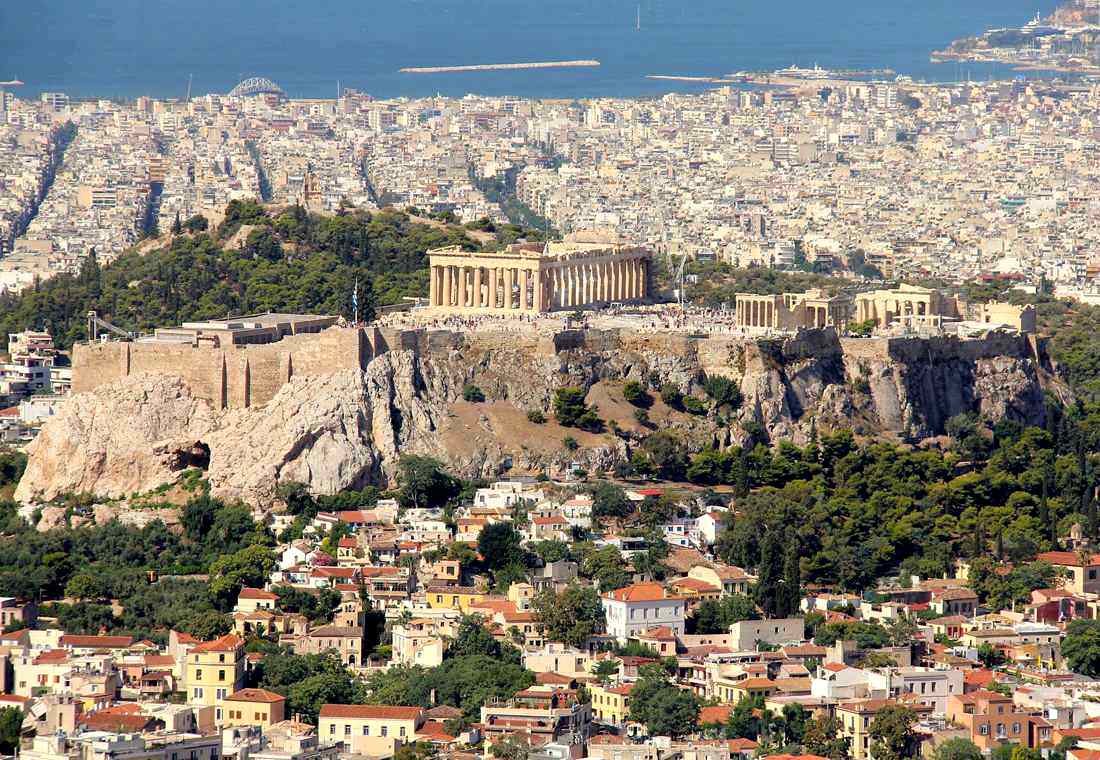
The Acropolis is a 156-meter high rocky hill and a monument of ancient architectural art. Although there is evidence that it was inhabited as early as the fourth millennium BC. The most important buildings are the Parthenon, the Propylaea, the Erechtheion and the Temple of Niki Aptheros, which were built in the 5th century BC on the initiative of Pericles. The Parthenon and other buildings were severely damaged during the siege by the Venetians in 1687, during the Turkish-Venetian War of 1684-1699, when gunpowder stored in the Parthenon was hit by a cannonball and exploded. The first fortifications on the rocky hill appeared long before the classical period. Already in the Archaic times there were majestic temples, sculptures, various cult objects. The Acropolis is also called "Kekropia" or "Kekrops" in honor of Kekrops, who according to legend was the first king of Athens and the founder of the Acropolis. In the Mycenaean period of the XV-XIII centuries BC, the Acropolis was a fortified royal residence. In VII-VI centuries B.C. there was a great construction here. Under the tyrant Pisistratus 560-527 BC on the site of the royal palace was built a temple of the goddess Athena Hecatompedon (that is, a temple of a hundred steps long, fragments of sculptures of pediments are preserved, the foundations are revealed). In 480 BC during the Greek-Persian wars, the temples were destroyed by the Persians. The inhabitants of Athens vowed to restore the shrines only after the expulsion of the enemies from Greece. In 447 BC on the initiative of Pericles on the Acropolis began a new construction, the management of all works was entrusted to the famous sculptor Phidias, who apparently is the author of the project, which formed the basis of the entire complex, its architectural and sculptural appearance. Callikrates, Ictinus, Mnesikles, Archilochus and others also worked on the project. In the 5th century the Parthenon became the Church of Our Lady, and the statue of Athena of the Parthenon was moved to Constantinople. After Athens was conquered by the Ottoman Empire in the 15th century, the temple was turned into a mosque, and minarets were added nearby and later turned into an arsenal. The Erechtheion became the harem of the Turkish pasha, the temple of Niki Aptheros was dismantled, and its blocks were used to build the wall of the bastion. In 1687, after a cannonball hit from a Venetian ship, an explosion destroyed almost the entire central part of the Temple of Athena and when the Venetians tried to remove the sculptures from the Parthenon temple, several statues were smashed. In the early 19th century Sultan Selim III allowed any piece of stone with inscriptions or images to be taken from Greece and the British diplomat Elgin took to Britain a large collection of statues, architectural and sculptural fragments, inscriptions, plaster casts, vases, bronzes, coins and stones.

In 1827, during the defense of the Acropolis by Greek rebels, the temple of Erechtheion was severely damaged by Turkish cannonballs. Previous attempts by the Turks to blow up the Acropolis by means of digging were thwarted by the Greek sapper Kostas Hormovitis, whose name is given to one of the central streets. After the declaration of Greek independence, restoration work began, mostly in the late 19th century. The Acropolis was restored to its ancient appearance and late buildings were demolished, while the temple of Niki Aptheros was rebuilt. Reliefs and sculptures of the temples of the Acropolis are in the British Museum, the Louvre and the Acropolis Museum. The sculptures that remained in the open air have now been replaced by replicas.
Location plan

1. Parthenon

An ancient temple in Athens dedicated to the goddess Athena, the patroness of the city and the whole of Attica. It was built in 447-438 BC by the architect Kallikrates, designed by Ictinus, and decorated in 438-431 BC under the direction of Phidias during the reign of Pericles. The Parthenon was used as a treasury, fortress, church and mosque. Today, the Parthenon is one of the most popular tourist attractions and one of the most recognizable structures in the world. The Parthenon is the main attraction not only of the Acropolis of Athens, but of the whole of Greece. It is unlikely that you will find a more famous structure built in Ancient Greece.
2. Hecatompedon
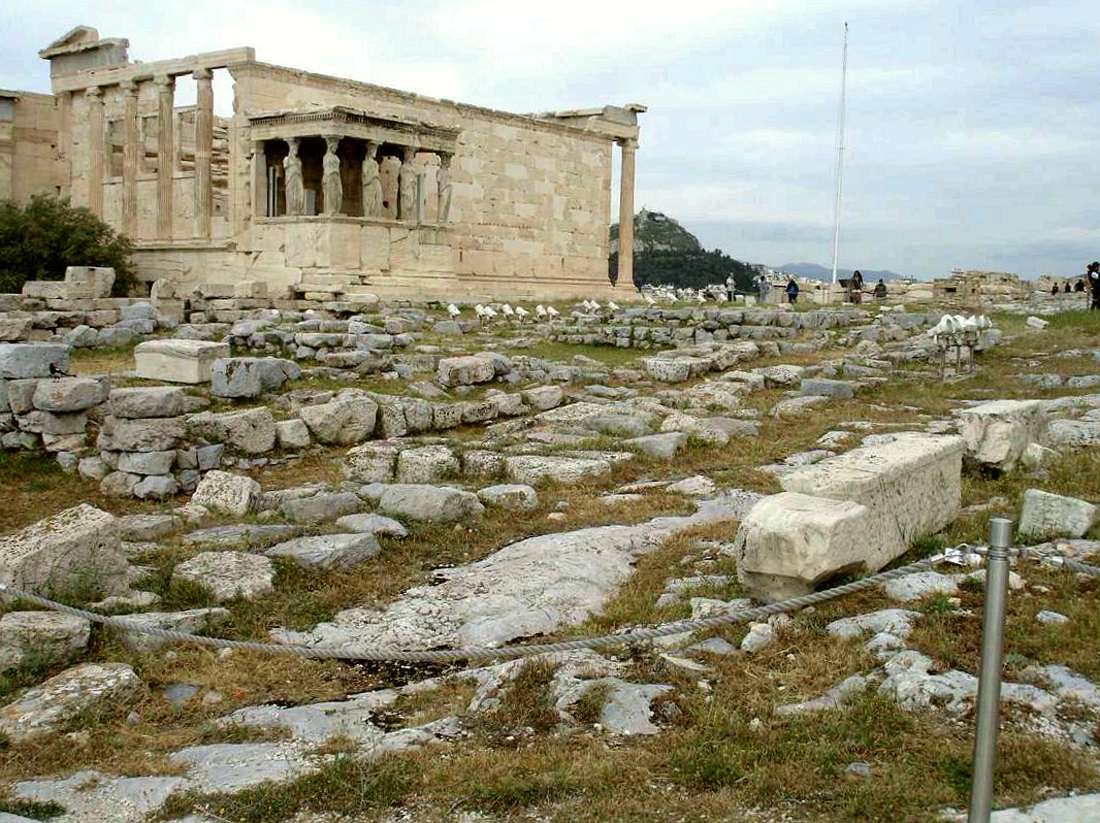
The Hecatompedon is the predecessor of the Parthenon (sometimes the term pre-Parthenon is used). The temple was built in the middle of the 6th century BC during the reign of Pisistratus within the grounds of an even older Mycenaean royal palace dating from around the 14th century BC, the temple was located opposite the Propylaea. The temple was dismantled in 490 B.C. by the Athenians, just after the victory over the Persians at Marathon, to build a new temple known as the Proparthenon. But this temple was destroyed by the Persians in 480 BC, while it was still under construction, and the modern Parthenon was erected in its place. The ruins of the building were found by the German archaeologist Wilhelm Derpfeld in the XIX century during excavations on the Acropolis. It is believed that the sculptures that decorated the pediment of the Hecatompedon have survived to this day (they are kept in the new Acropolis Museum). The temple received its conventional name due to the size of the cella - 32.8 meters and by 16.4 meters. The ruins of the temple are located between the Parthenon and the Erechtheion, but if you don't know and don't read the explanatory boards, you will just pass by.
3. Altar of Athena Polias
The Palladian Altar of Athens was the most iconic site on the Acropolis. Nowadays, the location of the altar can only be guessed at. It was here that cattle were sacrificed to Athena during the Panathenaic celebrations (it is believed that a whole herd was slaughtered). The parts that could not be eaten were burned as a gift to the gods, and the meat was distributed to the Athenians. Modern historians know nothing about how the construction of the altar looked like, but it is believed that it was a marble platform with a staircase, which was used for sacrifice. The foundation of the altar of Athena Pallada was laid in 525 BC by the sons of Pisistratus.
4. Erechtheion

The Erechtheion is probably one of the most memorable temples of the Acropolis, which may well rival the Parthenon in popularity. This monument of ancient Greek architecture was built in 421-406 BC and is dedicated to the main Greek deities Athena and Poseidon, as well as the Athenian king Erechtheion. Every year millions of tourists from all over the world come to Athens to see with their own eyes the unique architecture of the temple, to immerse themselves in its history and of course to see the famous portico of caryatids, which has become not only a visiting card of the Acropolis, but also a symbol of the ancient Greek heritage.
5. Athena Promachos
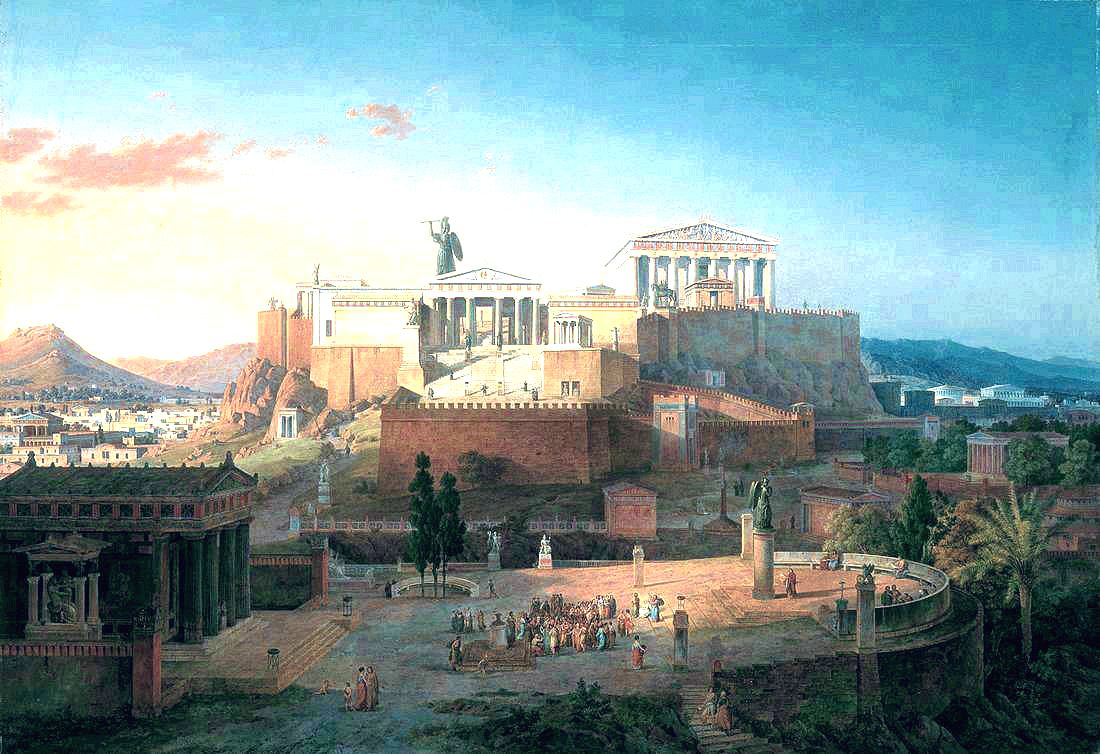
The bronze statue of Athena Promachos stood between the Propylaea and the Erechtheion. It was designed by the famous sculptor Phidias. Athenians dedicated the statue to Athena to express their gratitude for her contribution to victory in the Persian wars. Later sources claim that its creation was financed from Persian spoils. According to financial records, the construction of the statue dates back to between 475 and 450 BC. The exact shape of the statue is not known, but later copies and coins from Roman times show the goddess standing, in a relaxed pose and wearing a peplos (expensive clothes) with a sash. According to another version, on the outstretched right hand was Nika (Victory) or an owl. The pedestal of Athena, measuring 5x5 meters, was repaired in the Roman period, probably during the time of Augustus (31 B.C. to 14 A.D.). Fragments of its crowning composition with relief moldings have survived to this day. Phidias' masterpiece was transported to Constantinople and placed in the Hippodrome, probably in the 5th century AD. The statue was destroyed in 1204 by an angry mob during the siege of the city by the Franks. People believed that Athena's outstretched hand attracted the enemy.
6. Propylaea

The impressive front entrance was built in 437-432 BC, presumably by the architect Mnesicles, on the ruins of the ancient Propylaea, and is one of the masterpieces of classical architecture. The main material was marble, but on the Acropolis other material was not very recognized and almost all temples were built of white or gray marble. On the Acropolis, Ionic and Doric columns were used in construction. Scientists agree that it is in the construction of the Propylaea these two styles were used simultaneously for the first time. The central part of the structure is five gates and a central corridor, which was to become for the ancient Greeks the culmination on the sacred path. In ancient Greek architecture, the Propylaea is the front gate made with porticoes and columns. A grand entrance like the gates of the ancient Acropolis. The word "Propylaea" comes from the prefix "Pro" (Latin before or in front of) and "Pileia" (Greek gate), which literally translates as "before the gate", meaning the gate of the building. The monumental gates of the Acropolis were built under the overall direction of the Athenian leader Pericles, but responsibility for the work of rebuilding the Acropolis itself after the Persian wars fell to Phidias.
7. Temple of Athena Nike
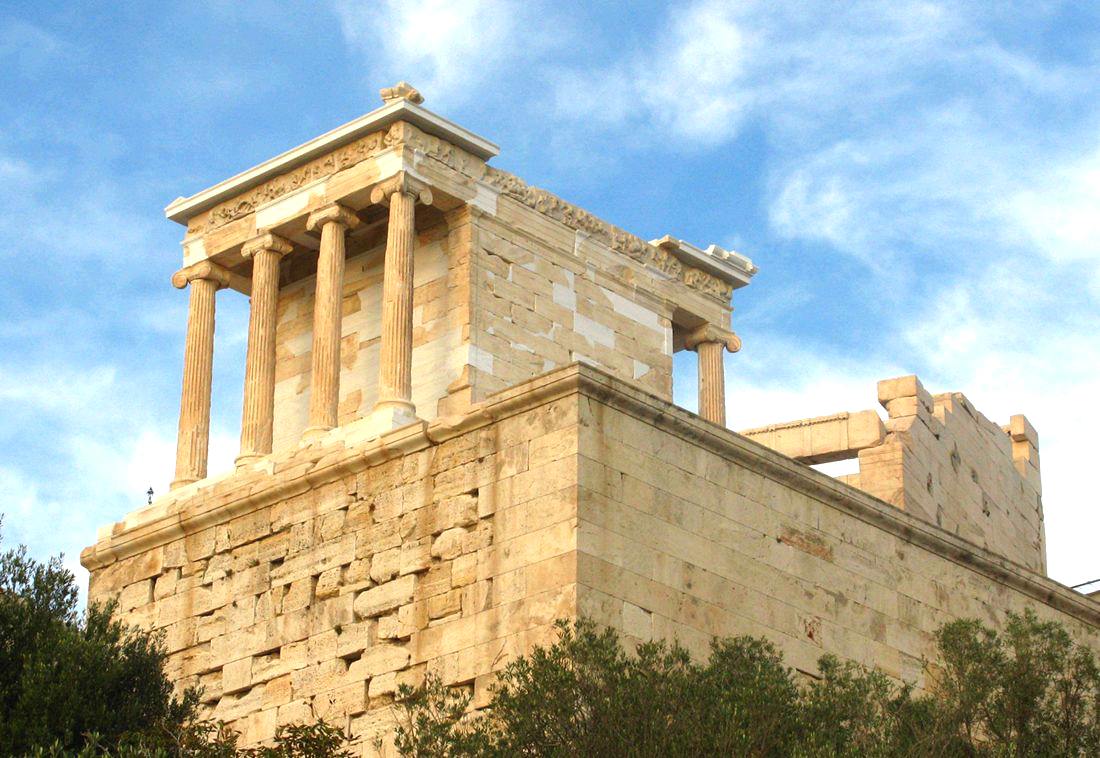
The temple was built in 427-424 B.C. according to the project of the architect Kallikrates. The temple of Niki Aptheros has survived to this day a real miracle, and not even one, but several fortunate sections of circumstances. The temple was originally wooden, but it was destroyed during the Persian invasion and the altar was preserved. During the time of Kimon in the middle of the V century BC, the temple was rebuilt in stone. Modest in its size, the temple was considered one of the most elegant and beautiful. During Christianity, statues of gods were removed from the facades, bright colors were erased, and the temple itself was turned into a church. The Christians were replaced by the Turks, who turned the temple of Niki Aptheros into a mosque, and continued further by the Venetians, who began to dismantle the temple in pieces to build fortifications out of marble, and lead fasteners were melted down into cannonballs and bullets. Fortunately, the Greeks managed to persuade the invaders to leave the temple alone and use other materials. However, during this time the temple suffered considerably and in 1935 it was dismantled due to the threat of collapse. The dismantling was temporary in order to strengthen the slope and then reassemble the temple, replacing the missing blocks with new ones. It was not until the early 2000s that the temple received its present form.
8. Temple of Aphrodite Pandemos
According to certain sources, at the top of the southern slope of the Acropolis there was a sanctuary dedicated to the goddess Aphrodite Pandemos and her faithful companion Peitho. Information about this structure on the Acropolis is extremely limited: only a few sources mention it on the diagram, but provide an extremely limited description.
9. Pelasgic wall
(Mycenaean Wall)
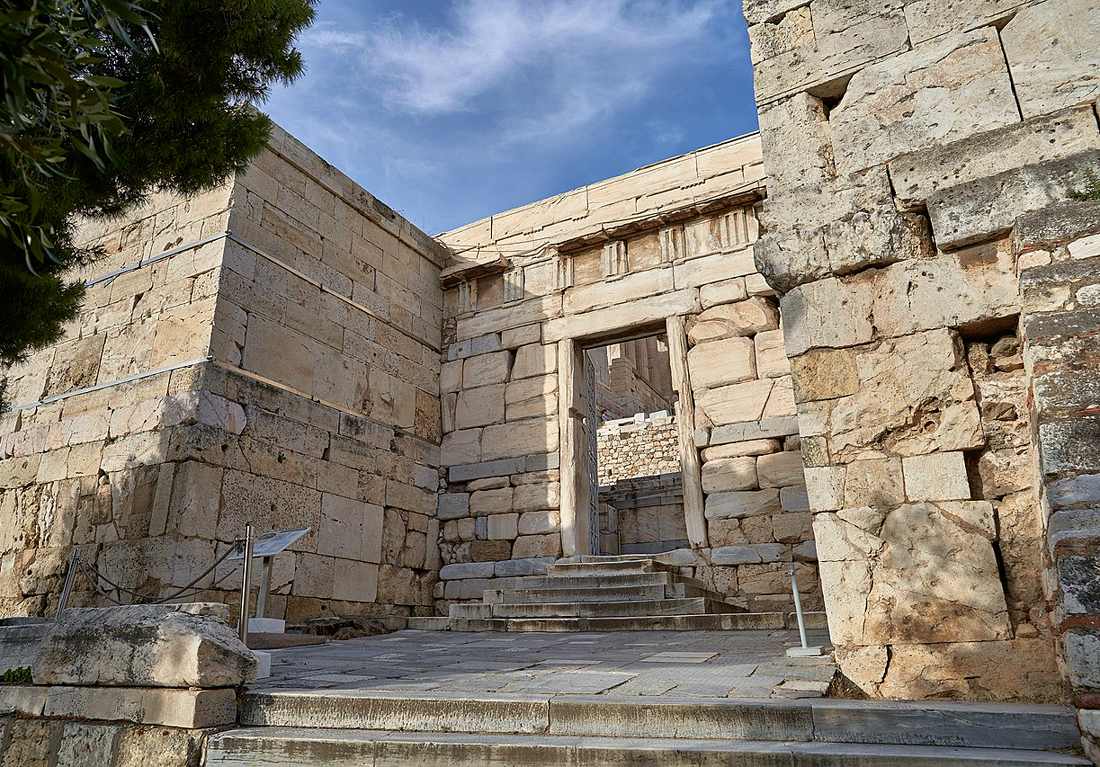
In the fourteenth and thirteenth centuries B.C., a wall called the Pelasgic Wall was built around the hill, on which all the temples of the Acropolis were later built. It is one of the few structures of the Acropolis of Athens that has survived from the Mycenaean era to the present day. According to some data, its width reached 6 meters. Nowadays, the remains of this wall can be seen at the base of the Propylaea. However, there is disagreement about this theory, which has both supporters and opponents.
10. Brauroneion
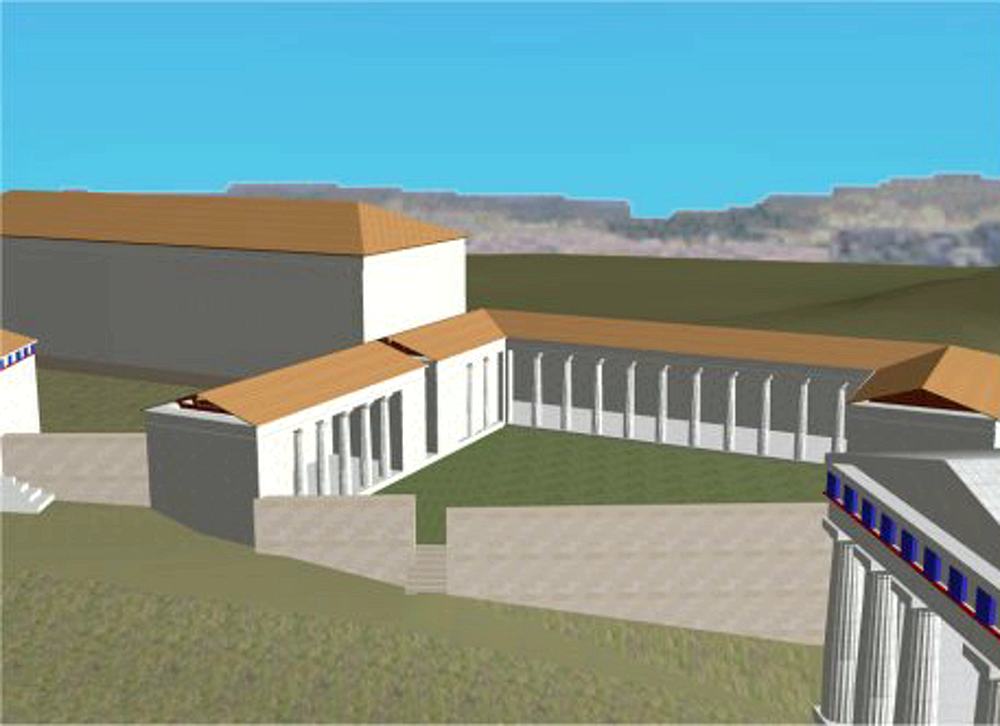
In the southwestern part of the Acropolis was the sanctuary of Artemis Bravronia, it is believed that the structure was erected in honor of the patroness of women who were preparing to become mothers. In the sanctuary was a wooden statue to which came to pray to all future women in labor. Later, according to Pausanias, there was a stone statue, created in 330 BC. Now the head of this statue can be seen in the new Acropolis Museum. The sanctuary on the Acropolis had an unusual trapezoidal shape and did not contain a formal temple, instead a portico or stoa served that function. The entire western part of the sanctuary (now lost) stood on the remains of the Mycenaean fortress walls. All that remains of the eastern part is the foundation for the walls cut into the rock, as well as very few architectural elements made of limestone.
11. Chalkotheke
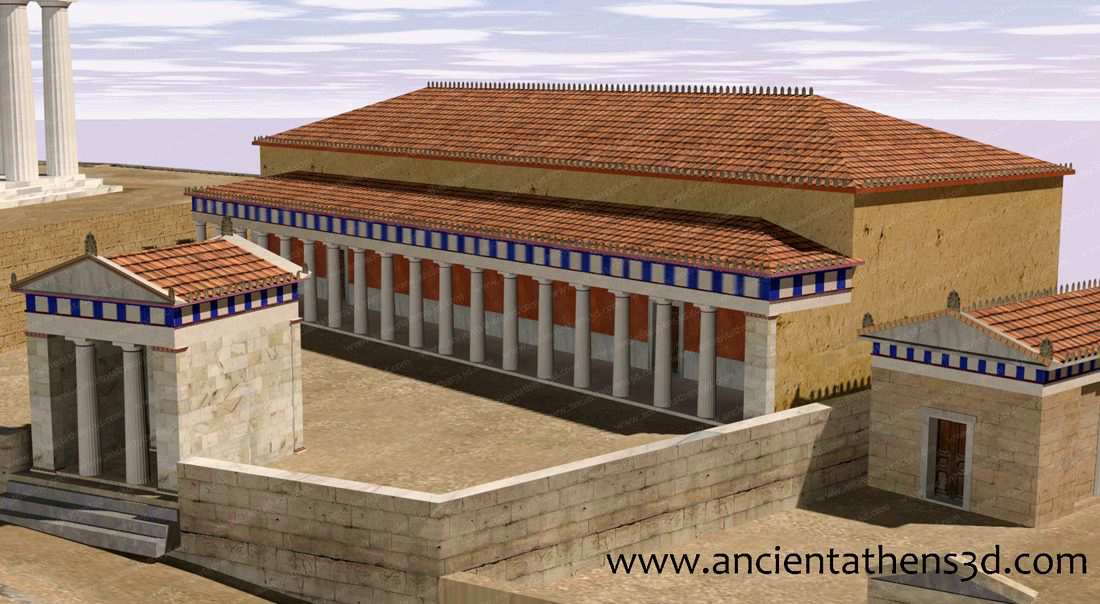
A special building with an opisthodome (inner room) that belonged to the Parthenon and served as a storehouse for utensils and weapons. Shields, armor, spears, greaves, catapults and other throwing weapons belonging to the city were stored here. The name and functions of Chalcotheca are known from inscriptions from the 4th century BC. The remains of the Chalcotheca have come to be regarded as ruins discovered east of the Bravroneion and in the immediate vicinity southwest of the Parthenon. All that remained of the building was a limestone foundation and foundation trenches cut into the rock. The building stood in front of the southern wall of the Acropolis, with a portico on the northern side. This suggests that the portico was built in the early 4th century BC, while the building itself appeared earlier, probably at the same time as the Parthenon, that is, in the middle of the 5th century BC. Apparently, the building was extensively renovated in Roman times and numerous fragments of architectural decoration belonging to the Roman era were found with the corresponding size of the Chalcotheca.
12. Temple of Athena Ergane
(possible location)
Right in front of the Parthenon, next to the sanctuary of Artemis Bravronia, there was another altar dedicated to Athena Ergana (patroness of craftsmen and manual labor). Unfortunately, there is very little information about that structure, moreover, archaeologists are still arguing about the location of this sanctuary. Perhaps in the future they will be able to solve this mystery of the Athenian Acropolis.
13. Pandroseion

Next to the Erechtheion are the ruins of the sanctuary of Pandrosa, one of the daughters of Kekrops, the first king of Attica, who together with her sisters preserved the infant Erechthonius. The building occupied a site adjacent to the Erechtheion and the old temple of Athena Pallada, and was an enclosed trapezoidal courtyard with an altar to Zeus Herkeios (protector of the hearth) under a sacred olive tree. In the northeast corner was an elaborate entrance to the north covered gallery and the entire Erechtheion complex. In the east was a small opening through which one could see the Thalassa of Poseidon. In addition, the Athenians honored her as the goddess of dew and protection from drought. According to some sources, near Pandroseion was an olive tree, which Athena presented to the inhabitants after the struggle with Poseidon for the patronage of Attica. The Pandroseion was a trapezoidal structure with one of its walls open, like a covered veranda.
14. Arrephorion
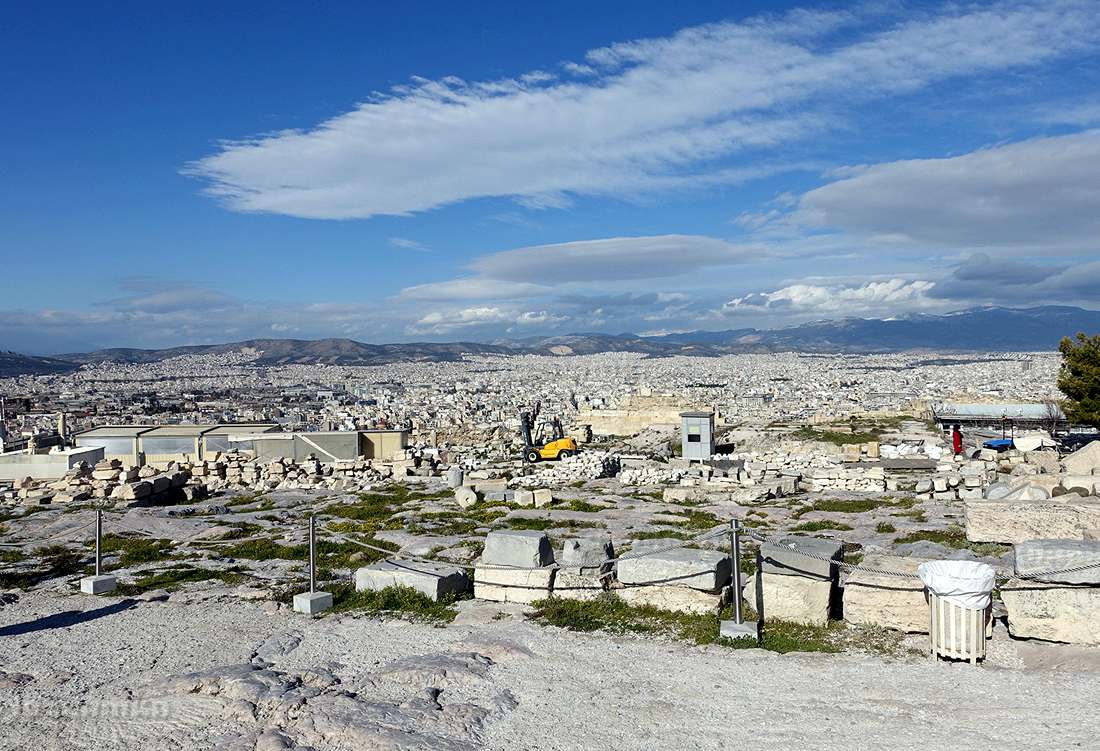
A small building located near the northern wall of the Acropolis and the wall of Pericles, found in 1920 by the German architect Wilhelm Dorpfeld. Here were living quarters for the Arrephorion, two (or possibly four) noble Athenian girls between the ages of 7 and 12. They lived in the Arrephorion for a year and wove peplos for the Panathenaic Games. This was a special kind of liturgy for the girls' parents, as they were obliged to provide gold jewelry for their daughters, which was then left in the Temple. According to the ritual, the girls carried the closed vessels to the Temple of Aphrodite at night and took other vessels from there, which they carried back to the Arrephorion. It was forbidden to look into the vessels. Perhaps this ritual was connected with calling dew to the fields. The building was about 12 meters square, with one room of about 38 m² and a portico 4 meters long. In the courtyard there was a descent to a path connecting it to the temple of Aphrodite. The building was constructed around 470 BC.
15. Sanctuary of Zeus Polieus
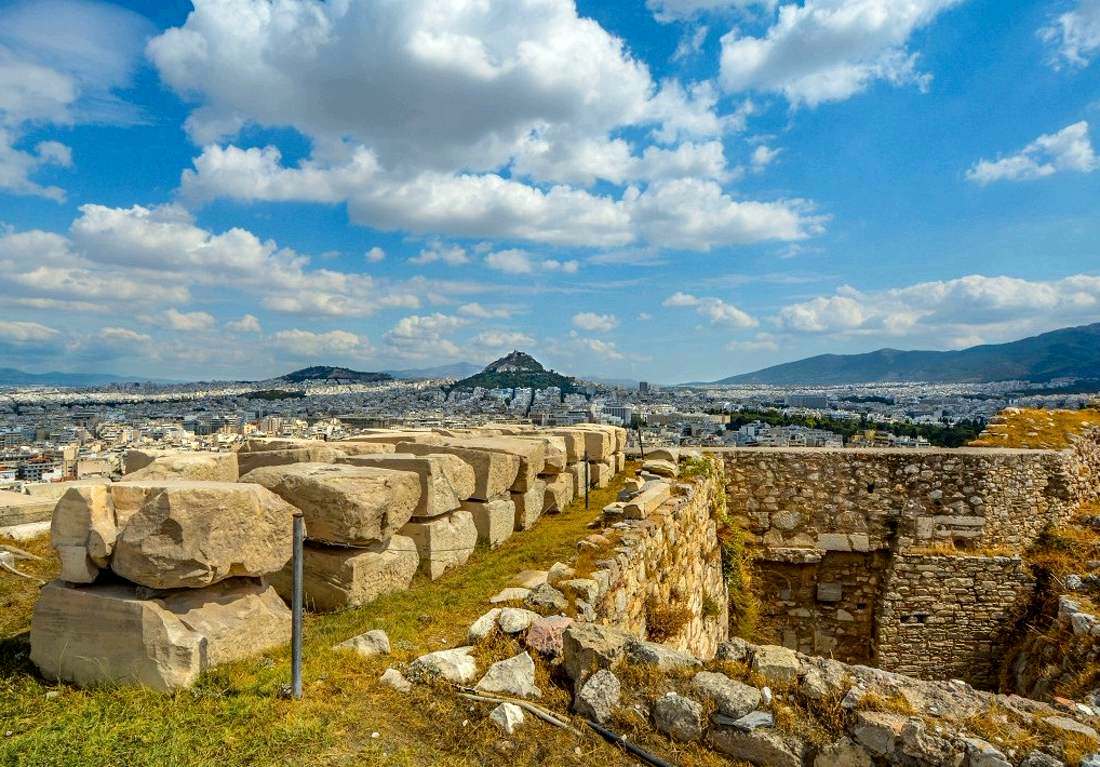
To the left of the tower with the Greek flag flying, a little to the side, lie the marble remains of the foundation of the columns and ornaments that once belonged to the ancient temple of Zeus Polias. To date from the building except for ruins and mentions in chronicles, nothing has survived. In ancient times, the temple was located in the highest point of Acropolis, behind Parthenon. It was a separate fenced area with a temple dedicated to Zeus and storage for gifts. In Athens, it was called Polyei, from the word "poly - city" that is Zeus the defender of the city. According to one sources in this part of Acropolis there was a temple of Zeus Polyades, and on other sources here there was a whole open quarter named in honor of Zeus the City Builder. Presumably it appeared in the V century BC, that is, a couple of decades before the construction of the Parthenon and other structures on the Acropolis. The temple was built specifically for the ritual sacrifice of bulls.
16. Sanctuary of Pandion
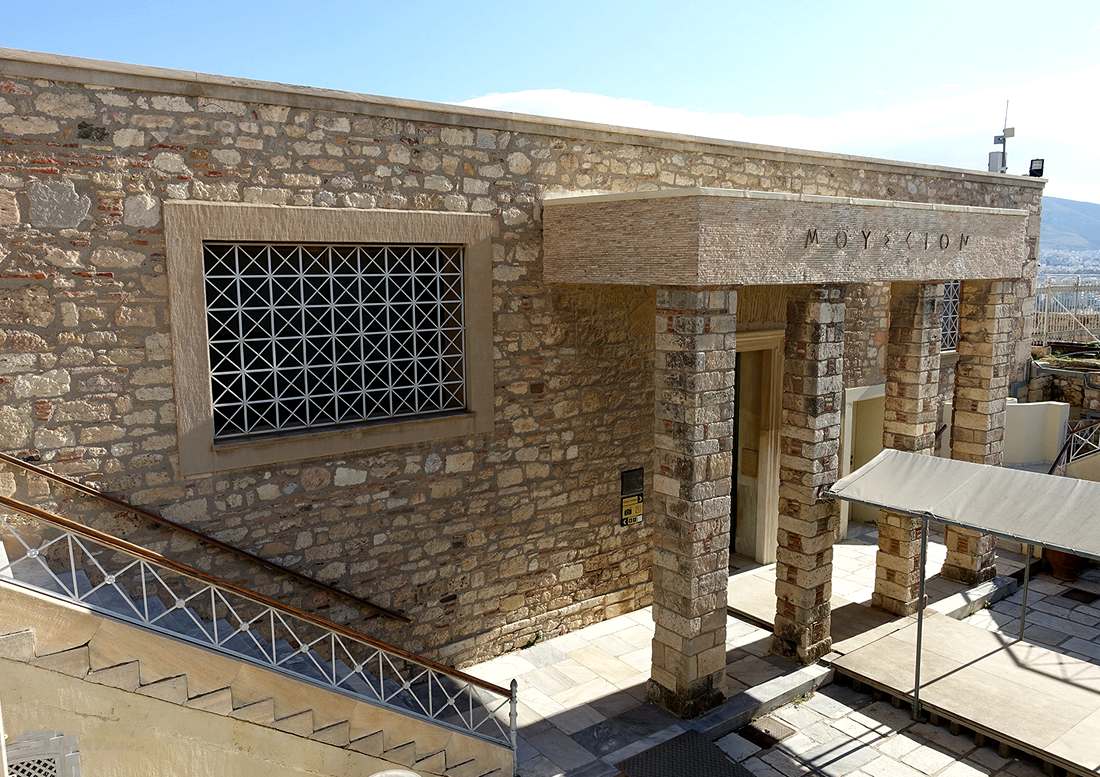
A ruined building located in the southeast corner of the Acropolis of Athens. Its foundations were found during excavations for the construction of the old Acropolis Museum (1865-1874). The roofless rectangular structure measured 40×17 meters, dated to the end of the 5th century BC and was divided by a wall into two almost equal parts. Its entrance was on the west side through a portico. The name is based on the assumption that the structure is the Pandion Heron (it is known that such a Heron was located somewhere on the Acropolis). Pandion is a hero of Greek mythology from the Attic cycle, usually interpreted as one of the two legendary kings of Athens, Pandion son of Erichthonius or Pandion son of Kekrops.
17. Temple of Roma and Augustus
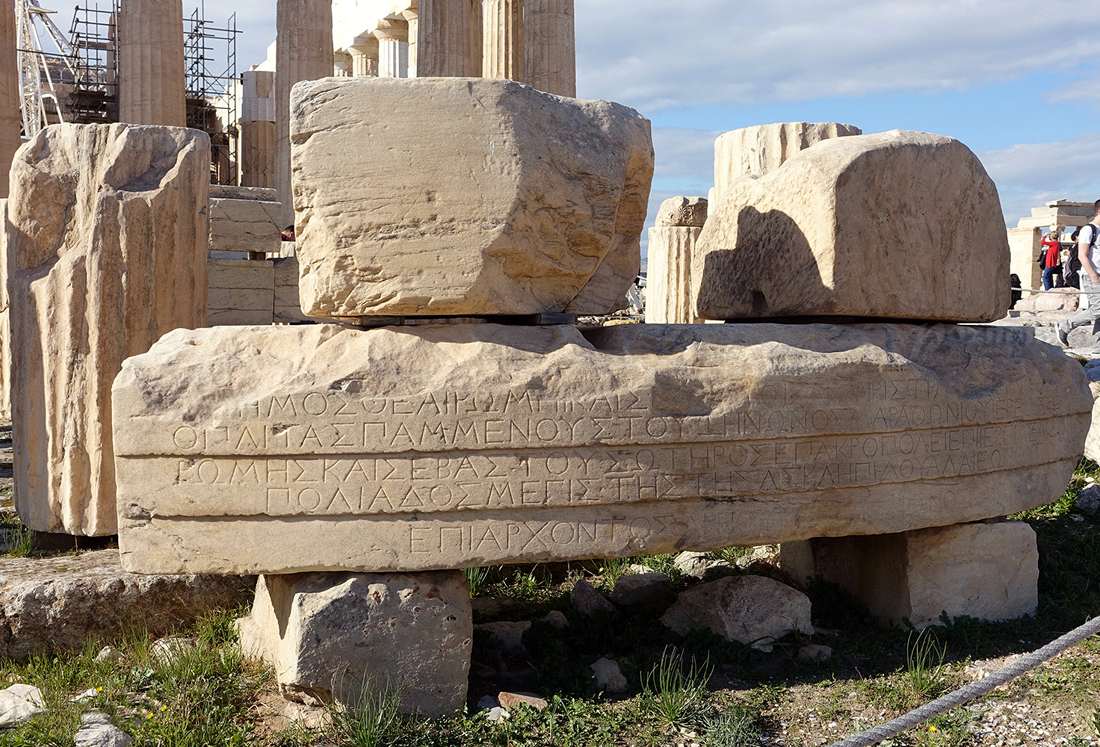
The ruins of another temple of Augustus and Roma can be found in front of the eastern facade of the Parthenon, but only parts of the columns and fragments of the circular base remain. This is not much, but considering that some structures are almost completely destroyed, it can be considered a great achievement. The temple was erected during the Roman Empire in honor of the goddess Roma, the patroness of Rome and the Roman Emperor Augustus. It was built at the end of the first century BC and was the only circular structure on the Acropolis.
18. Pedestal of Agrippa
The pedestal of Agrippa can be seen next to the Propylaea. Thanks to the semi-erased inscription and the architectural features of this structure, archaeologists have reliably established that the pedestal appeared on the Acropolis in the second half of the 2nd century BC. The height of the pedestal, if we do not count the limestone base, is almost 9 meters (the total height of the base and pedestal is almost 13.4 meters). Initially on the marble pedestal there was a monument of the Pergamon king Eumenes II and his brother Attalus, made of bronze. Later, statues of Antony and Cleopatra were placed in this place, but in 31 BC they were demolished. A few years later, a monument dedicated to Marcus Agrippa, the son-in-law of Emperor Augustus, was erected on the pedestal as a token of gratitude for the Odeon at the Agora.
19. Beulé Gate

After the Heruli raid in 267, two new gates were added to the fortress wall of the Acropolis. One of them was found in 1852 by the French architect and archaeologist Ernest Beulé, and they were named after him. The Beulé gate was built from material left over from earlier buildings. For example, here you can see blocks from the choregic monument of Nikia, located on the southern slope of the Acropolis, fragments of the stoa of Eumenes and even parts of the theater of Dionysus.
20. Odeon of Herodes Atticus

Herodotus Atticus built the theater in 165 AD, in honor of his late wife Regilla. The Odeon has the classical form of an ancient theater with 5,000 seats, in which almost everything has been preserved, except for the statues in the niches and the colorful marble lining. You can get inside only during concerts and performances by paying for a ticket. The marble lining of the seats for the audience and the stage was restored in 1950. Since then, the Odeon has been one of the main stages of the annual Athens Festival, held in the Greek capital from June to September. Maria Callas, Mikis Theodorakis, Nikos Portokaloglou and many others have performed at the theater.
21. Stoa of Eumenes
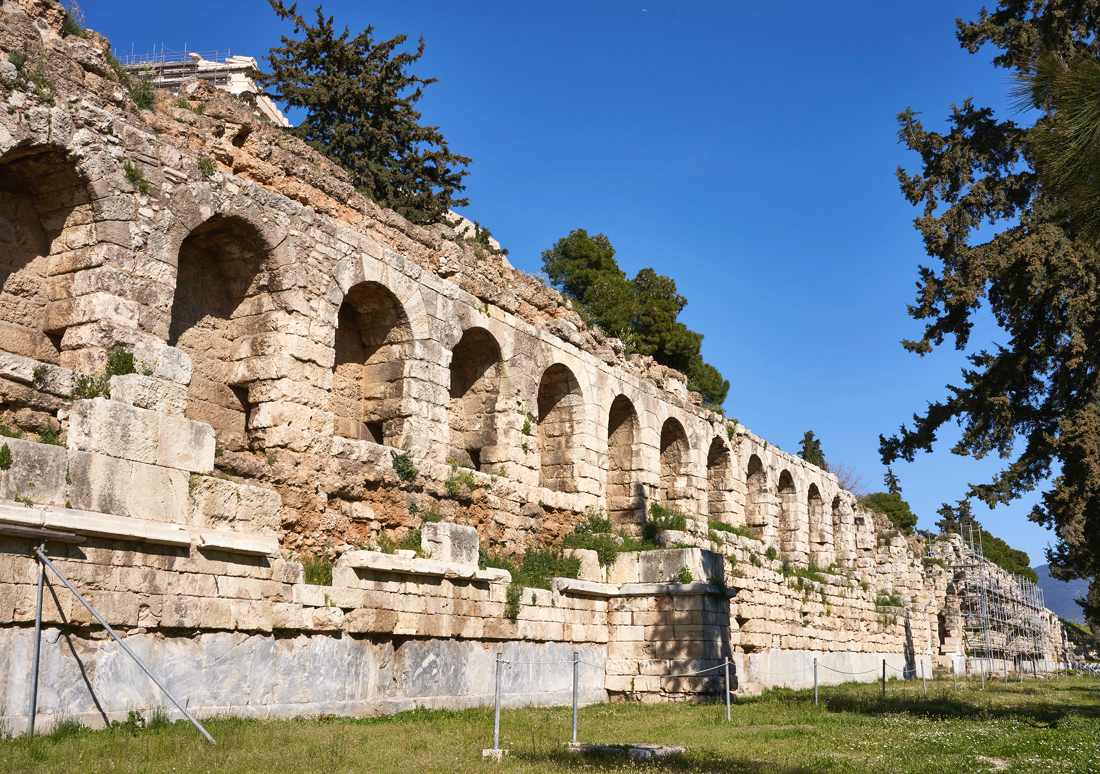
The Stoa of Eumenes is located between the Odeon of Herodes Atticus and the Theater of Dionysus. The Stoa were built by King Eumenes II of Pergamon. His example was followed by his successor brother Attalus II, who built the Stoa of Attalus in the Agora, probably with the help of the same architect. The Stoa of Eumenes differed from the Stoa of Attalus in that they were 46 meters longer and had no room behind the two-day hall. They were not built for conducting business, but for strolling visitors to the theater of Dionysus. The Stoa was a two-story building with Doric columns on the outside and Ionic columns on the inside and Pergamon-type capitals on the upper tier. Since the Stoa were built on the hillside of the Acropolis, they were protected by a wall of supported pillars and arches. The arches faced with marble have survived to this day. In 1060 the buildings on the southern slopes of the Acropolis were included in the fortifications of the citadel, which were called Rizokastron. The protective wall running from the Propylaea included the outer walls of the Theater of Herod Atticus, the arcades of the Stoa Eumenes and the walls of the Theater of Dionysus. The Roman author Vitruvius said that the Stoa served as a shelter for spectators in inclement weather and as storage areas for scenery and costumes.
22. Asclepieion
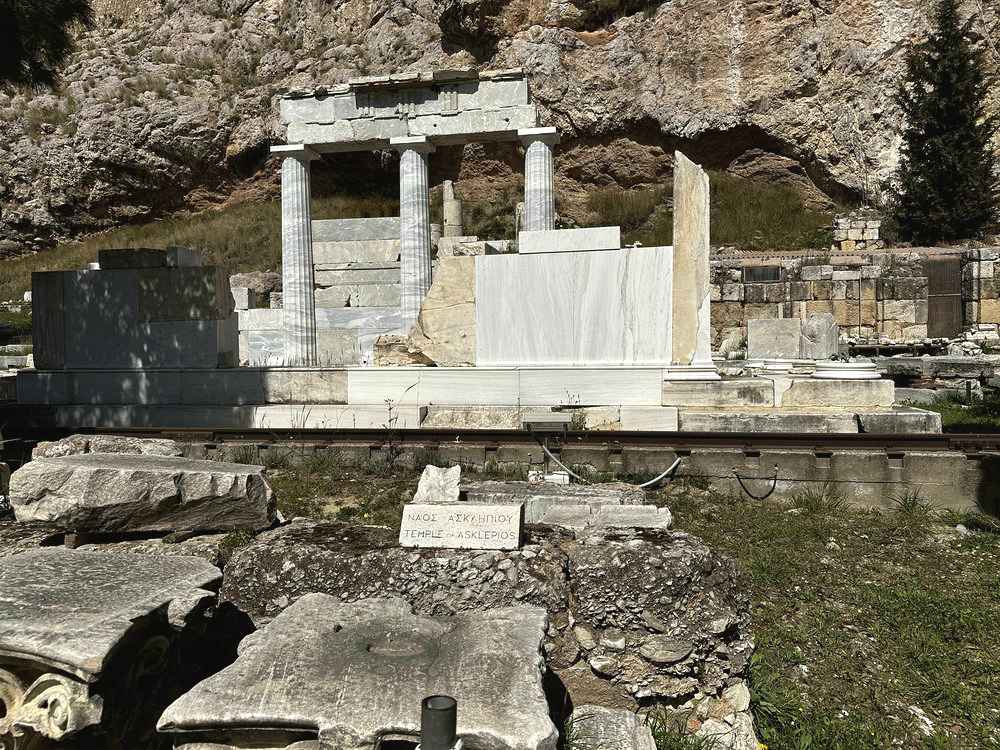
An ancient Greek temple dedicated to Asclepius, the founder of medicine
Asklepios is the second most important sanctuary on the southern slope of the Acropolis Hill after the Temple and Theater of Dionysus. It was founded during the Peloponnesian War (431-404 B.C.) and its appearance may have been related to the plague that left Athens half empty from 429 to 427. In Athens the Asklepion was built on the initiative of a certain Telemachus of the deme Acharne in 420-419. Asklepios were not only religious buildings, but also medical institutions. In fact, the temple served as a hospital, like a hospital in our time. Asklepions had a significant impact on the development of medicine in ancient Greece. The priests of Asklepion Asklepiades were engaged in the treatment of the sick, at the initial stages it consisted in the fulfillment of certain rituals. The patient had to spend the night in Asklepion, after which he had to tell about his dreams to the priest Asklepiades. On the basis of the dream, treatment was prescribed. The duty of the priests was also to draw up tables (patient's book), which described the patient's illnesses and the therapeutic measures taken and what results they led to. Thus the Asklepiads contributed to the accumulation of medical knowledge in temples called Asklepions, in honor of the founder of medicine, Asclepius.
23. Theatre of Dionysus

The theater is located on the southeastern slope of the Acropolis and is among the oldest theaters in the world. It was built in the 5th century BC and was initially wooden. Performances in the theater took place twice a year during the Minor Dionysia and the Great Dionysia. During the Great Dionysia, theater competitions were held in Athens. Usually three authors of tragedies competed. Each of the participants staged three tragedies and one satyr's drama, in a humorous form played mythological plot. The authors of comedies also competed, staging one play each. The results were recorded in special inscriptions didaskaliah, which were kept in the Athens State Archives. The general management of the theatrical spectacles was carried out by the Athenian archon. Around 326-325 BC the theater was reconstructed, the wooden stage and rows of seats were replaced by marble ones. Stone benches stretched along 67 rows, reaching all the way to the walls of the Acropolis. After the reconstruction, the theater could seat up to 17,000 spectators, which at the time was about half of Athens' population.
24. Temenos of Dionysus
Temenos is a sacred area dedicated to a certain deity. It was believed that being in Temenos one could feel the presence of this deity. Near the Acropolis, the archaic temple of Dionysus stood just behind the theater. A newer temple in the Doric style built around 340 B.C. stood a few meters south of the old temple.
25. Choragic Monument of Thrasyllos
At the top of the Theater of Dionysus is a small grotto, where in ancient times there was a small church of Our Lady of the Golden Cave. The entrance to the church was erected and decorated by the monument of Thrasil in 320 BC. Surprisingly, the monument managed to stand untouched for almost two millennia. And only in the first half of the 19th century during the Turkish siege of the Acropolis was destroyed. At the beginning of the 21st century, a large-scale restoration began in this part of the southern slope.
26. Choragic Monument of Nikias
The monument was erected as a temple in Doric style in 320-319 BC, at the expense of the commander Nikias, in honor of him the monument and received its name. According to one of the versions it was destroyed during the attack of the Gerulians in 267, according to another it suffered from an unsuccessful made drain (because of which the stairs of Stoa Eumenes collapsed). After the monument was destroyed, it was not rebuilt and the remaining materials were used to build the Belé Gate.
27. Odeon of Pericles
Pericles' Odeon was a greenhouse at the foot of the Acropolis, near the entrance to the Dionysus Theater. Themistocles built an early version of the Odeon after the great victory over the Persians, at Salamina in 480 BC, using the wooden masts of captured enemy ships as material to support the roof. Most theories agree on the fact that it was built in 435 BC for the performances and musical events of the Panathenaeus. It was also used as a courthouse, a grain store, a gathering place for cavalry, and a lecture hall for philosophers. Some ruins have survived, but it seems to have been decorated with stone columns (according to Vitruvius and Plutarch) square-shaped columns instead of the usual round-shaped columns. The Odeon was covered with wooden cladding made from captured Persian ships with a square pyramidal roof that looked like a tent. Pausanias wrote that before the reconstruction of the Odeon in the 1st century BC, there was a replica of Xerxes' stage. Its name was established to distinguish it from two later Roman buildings such as the Conservatory of Agrippa and the Odeon of Herodotus Atticus.
28. Peripatos
(ancient path around the Acropolis)
Peripatos is the road that ran around the mountain on which the Acropolis was built. This is the path that people used to walk along during religious festivals. From the main road, there are several forks in the form of stairs and paths that lead to various sacred places. The length of the whole Peripato is about 1100 meters.
29. Source of Clepsydra
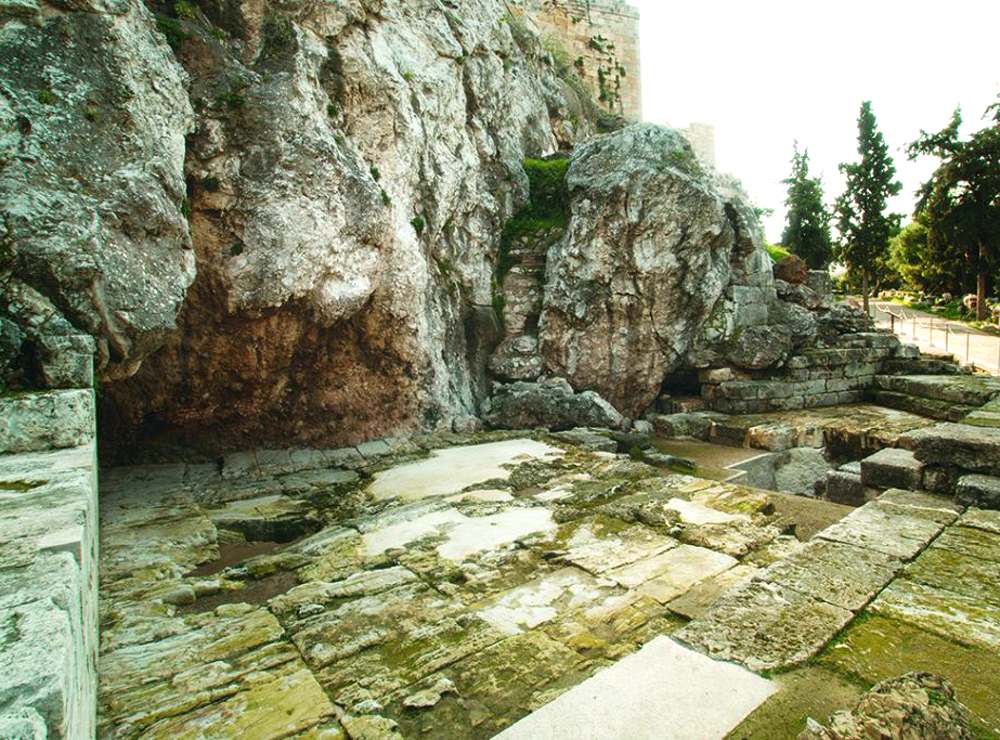
On the northern slope is the Klepsidra spring, there were three springs near the Acropolis, all of which were filled with rainwater. Klepsidra is considered to be the oldest and most frequently used spring by Athenians, it was used according to some data up to the XIII century AD. During the Christian period, the waters of the Klepsidra spring were considered holy, and therefore a church was built next to it. When the church was destroyed, its wreckage buried the spring, which was only discovered in 1822.
30. Caves of Zeus, Pan and Apollo

Some of the most interesting sights on the northern slope of the Acropolis of Athens are the caves. There are three caves on this slope: the Cave of Pan, the Cave of Apollo and the Cave of Zeus. The cave of Pan got its name in honor of the god who patronized shepherds and protected forests. In Christian times, a chapel of St. Athanasius was built here, but it has not survived to this day. The largest cave is dedicated to Zeus. The last cave was dedicated to Apollo.
31. Mycenaean Fountain
In the northern part of the Acropolis rock is the Mycenaean Fountain. It is quite difficult to call this structure a fountain, because in reality it is a small cave called the Altar of Ersi. Mycenaean fountain was built in the XII century BC, during its excavation was found a lot of vases and vessels, which can now be seen in the new Acropolis Museum or in the National Archaeological Museum. The fountain was a deep well, but to draw water you had to climb down a ladder of about 40 meters. In fact, it was another secret passage to the Acropolis, which first served the ancient Greeks and then played an important role during the Second World War. During the German occupation of Greece, on the night of May 30-31, 1941, two Greeks, Apostolos Santas and Manolis Glezos, climbed the Acropolis through the Mycenaean fountain and tore down the Nazi flag.
32. Sanctuary of Aphrodite and Eros
Unlike most of the other sanctuaries of the Acropolis, the altar of the fertility goddess Aphrodite and her son Eros is located directly under the open sky. On the site of the sanctuary you can see small niches in the rock, in ancient times they were placed small gifts in the form of statuettes or vases. As a rule, here were religious rites of agricultural themes, because first of all Aphrodite was responsible for fertility. According to legend, it was near the sanctuary of Aphrodite and Eros held a secret ceremony in honor of Athena Poliades. It was held with the participation of girls Arrephorias. According to the descriptions of Pausanias, in one of the nights during the holiday priestess Athena handed the girls vessels and baskets, and neither the priestess nor the girls did not know what was inside. Then the girls went down a secret staircase that passed by the small sanctuary of Eros and Aphrodite and carried the baskets to the sacred place. There they would leave their gifts and take the other baskets, again not knowing what was inside. After the girls brought the secret objects to the priestess, they were released from the service and returned to their parents.
33. Borders of Peripatos

The Peripatos Inscription is the road around the Acropolis that connects all the slopes. It existed centuries before Christ and is confirmed by a huge stone known as the Peripatos Inscription, which bears both the name of the road and its length. The inscription is believed to have been made in the 4th century BC. Next to the stone there is a secret passage, according to legend, its length is about 35 meters, and it leads to one of the porticoes of the temple of Erechtheion.
34. Sanctuary of Aglavra

It is a large cave with dimensions of 22 x 14 meters. In 1980, a marble stele dating back to the 3rd century BC was found near the cave. It was this find that gave an unequivocal answer that this was none other than the sanctuary of the nymph Aglavra. Until 1980, archaeologists were sure that the sanctuary was located on the northern slope. After all, according to one of the legends in the sanctuary of Aglavra led a secret underground passage from the temple Erechtheion. If to look at the scheme of Acropolis, it is difficult to believe in it. According to Herodotus, it was through this secret passage in 480 BC Persians climbed the Acropolis. Aglavra is one of the three daughters of the mythical king Kekrops, the goddess of dew. Many myths are connected with her name, according to one of them the goddess of war gave the three daughters of Kekrops a closed box containing the infant Erechtheus (serpent son of earth) and strictly forbade them to look into it. Aglaurus and one of her sisters could not control their curiosity and opened it. After they saw the unusual child, they were horrified and threw themselves off the cliff, and a cave appeared at the place of their death. The second legend says that the oracle of Apollo informed that the long siege of the city would end only if someone would voluntarily sacrifice himself. Aglavra decided to take this step and threw herself down. At the place of her death a sanctuary was set up in front of which young Athenians entering adulthood took an oath and confirmed that they were ready for the same feats as Aglavra, for the sake of their people, and then received spears and shields. Athenians saw Aglabra first and foremost as a heroine whose self-sacrifice saved the city.
35. Panathenaic road
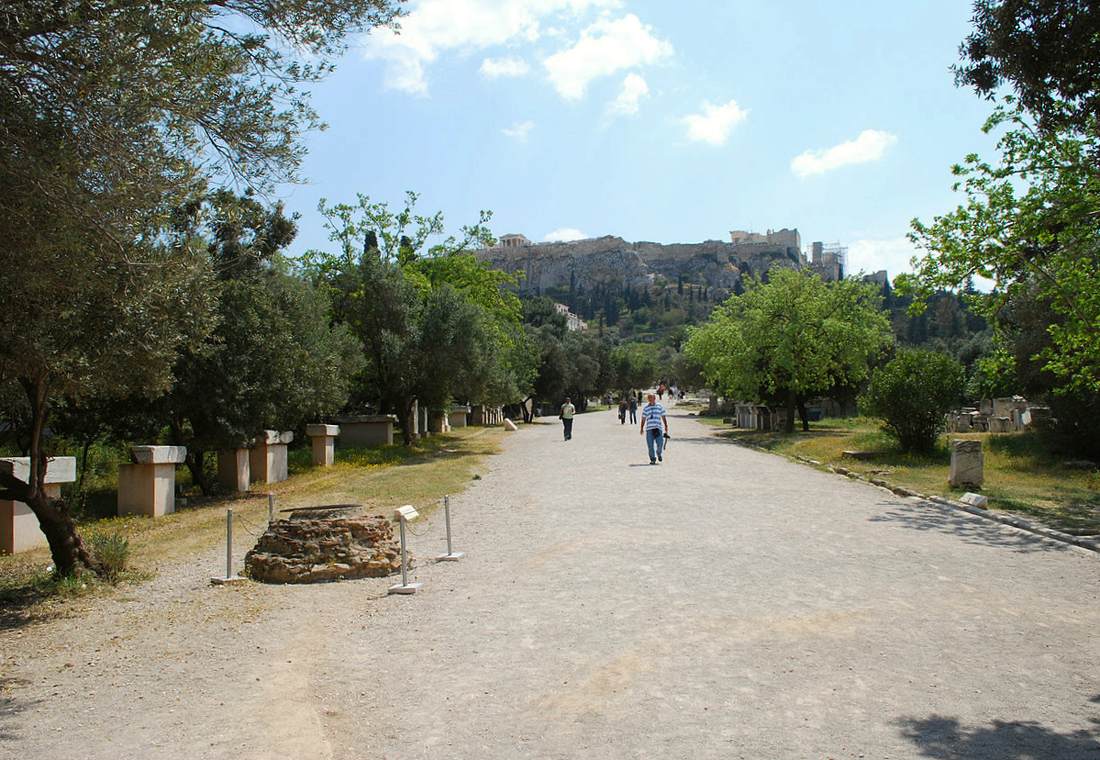
The Panathenaic Road is the main street of the ancient city. It started in the Kerameikos neighborhood, went through the ancient agora past the temple of Hephaestus and ended near the Acropolis. The road was named after the ceremony that took place along it during the celebration of the Panathenaea (the birthday of Athena, the patroness of the city).
Opening hours of the Acropolis of Athens
The Acropolis of Athens has two operating schedules: summer and winter.
Winter from November 1 to March 31: 08:00-17:00 (last entrance at 16:30).
Summer from April 1 to October 30: 08:00-20:00 (last entrance at 19:30).
Weekends: January 1, March 25, May 1, Easter Sunday, December 25-26.
Купить билет на Акрополь онлайн
Как доехать до Афинского Акрополя можно посмотреть на гугл карте
To leave your comment please log in or register.
Related publications
You may also be interested in similar information


